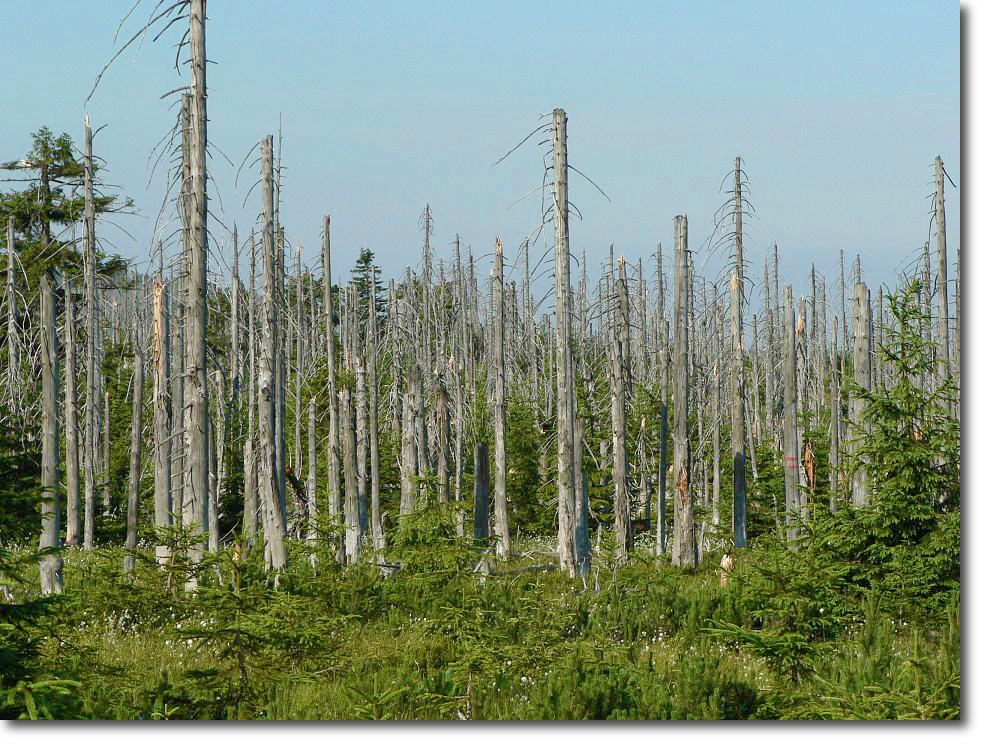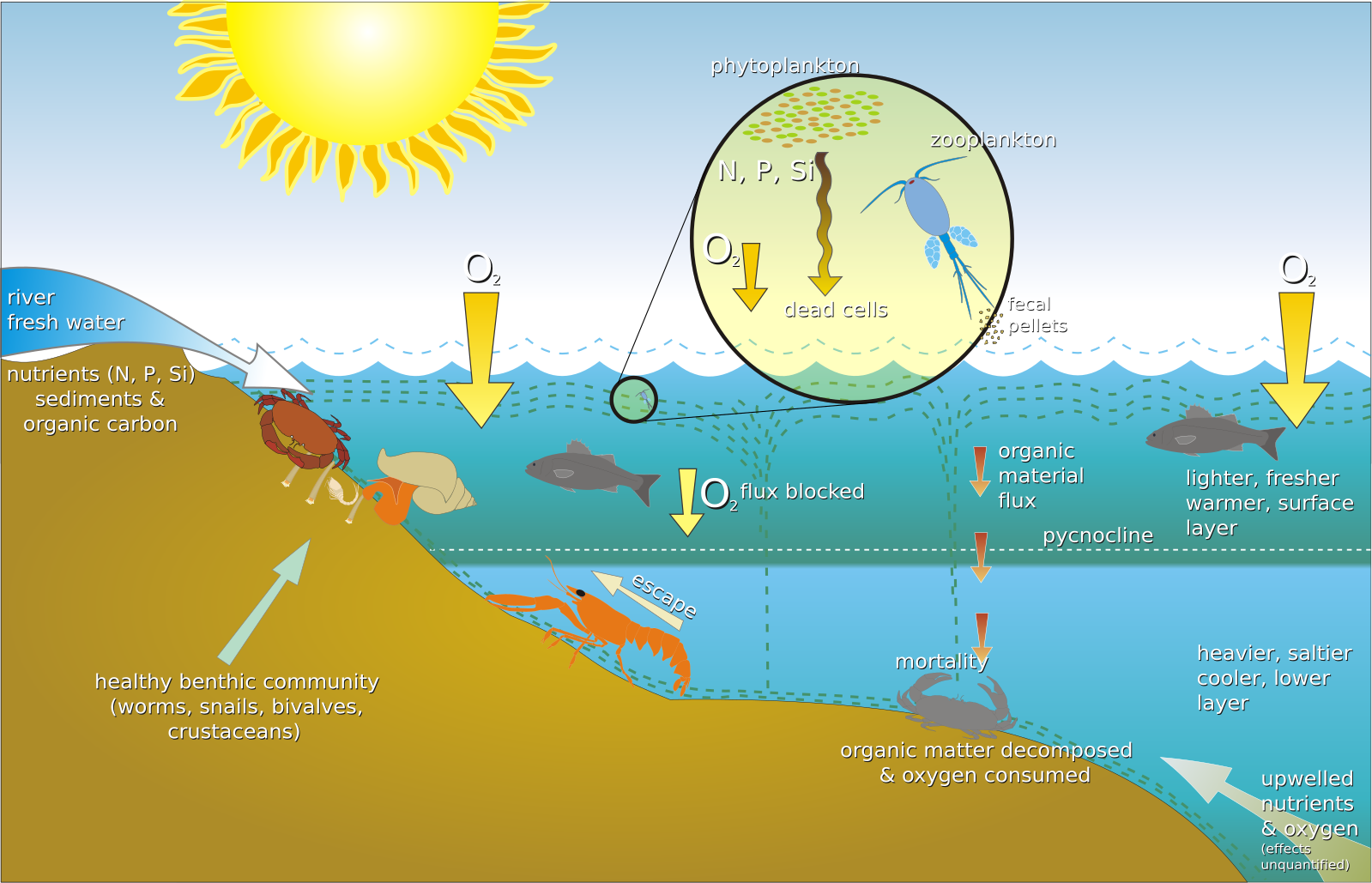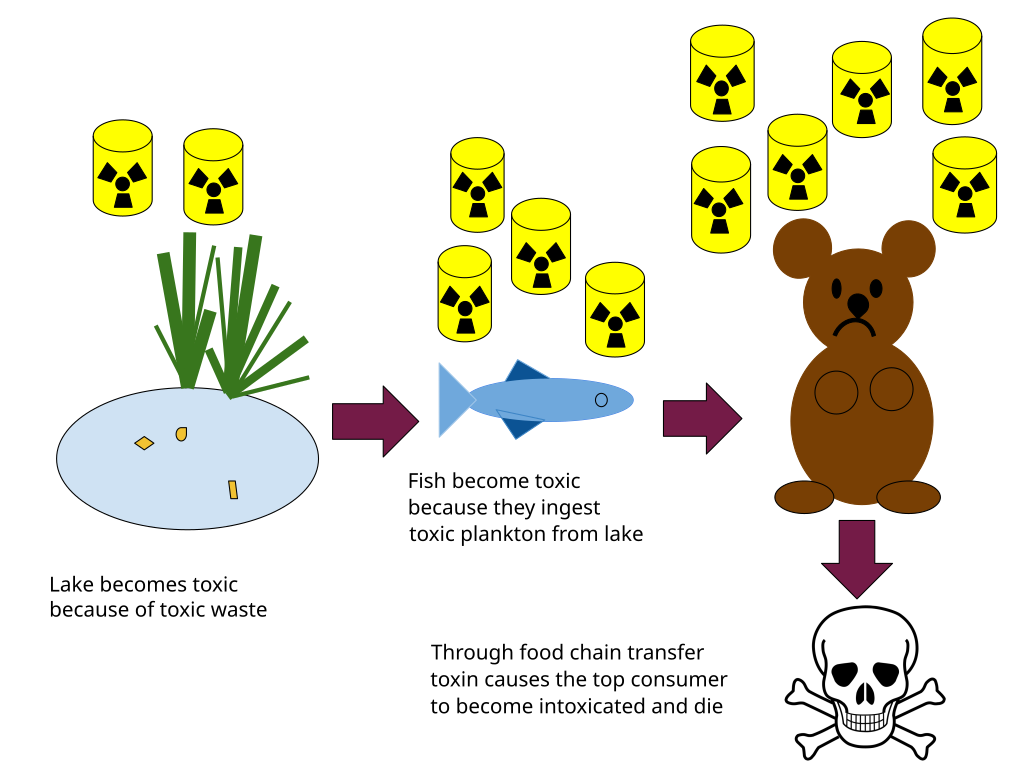Pollution, a critical issue, extends its adverse effects across environmental, social, and economic spheres, necessitating a comprehensive examination to fully understand its pervasive and multifaceted impacts.
Environmental Impacts
Air Pollution
Air pollution is a significant environmental concern, leading to a host of problems:
Climate Change: The emission of greenhouse gases like carbon dioxide and methane intensifies the greenhouse effect. This results in global warming and climate change, leading to rising temperatures, melting ice caps, and extreme weather events that disrupt ecosystems and human societies.
Acid Rain: Sulphur dioxide and nitrogen oxides, released from industrial processes and vehicle emissions, mix with water vapour in the atmosphere to form acid rain. This corrosive precipitation damages forests, soils, and aquatic ecosystems, leading to the loss of vegetation, soil degradation, and water pollution.

A USGS field photograph of forest decline associated with acid deposition. Such damage reflects nutrient leaching and aluminum mobilization that weaken and kill trees, illustrating the ecosystem consequences discussed in the text. Source.
Biodiversity Loss: Air pollution affects various species, leading to habitat destruction and loss of biodiversity. The toxic pollutants can cause respiratory issues, reproductive failures, and even death in animals, leading to a decline in species populations.
Water Pollution
Water bodies are not immune to the adverse effects of pollution:
Eutrophication: Excess nutrients, particularly nitrogen and phosphorus from agricultural runoff, lead to algal blooms. These blooms deplete oxygen levels in water, causing the death of fish and other aquatic life, leading to dead zones where life cannot be sustained.

This diagram shows how nutrient runoff drives algal blooms that reduce light penetration and, upon decomposition, deplete dissolved oxygen to create hypoxic “dead zones.” It links surface processes to bottom-water impacts on fish and benthos. The figure also includes water-column stratification detail beyond the syllabus scope. Source.
Contamination: Chemical pollutants, including heavy metals and industrial chemicals, contaminate water sources. This affects both aquatic life, leading to poisoning and death, and humans who rely on these sources for drinking water, leading to various health issues.
Habitat Destruction: Pollution alters the natural habitats, affecting the species that inhabit them. Oil spills, for instance, not only poison marine life but also destroy the physical environment, leading to long-term ecological damage.
Soil Pollution
Soil pollution impacts the land and ecosystems reliant upon it:
Fertility Reduction: Contamination by heavy metals, chemicals, and waste reduces soil fertility, affecting plant growth and the ecosystems dependent on these plants. This leads to reduced agricultural yields and the decline of species reliant on specific plants.
Toxicity: The accumulation of toxic chemicals in the soil affects plants, animals, and humans. Plants absorb these toxins, which then enter the food chain, leading to health issues in animals and humans.
Food Chain Contamination: As pollutants enter the food chain, they bioaccumulate and biomagnify, affecting a wide range of organisms and leading to ecosystem imbalances.

This labeled food-chain graphic demonstrates biomagnification: contaminant concentrations increase from producers and zooplankton to fish and a top predator. It reinforces that even low environmental levels can yield high body burdens at higher trophic levels. Source.
Social Impacts
Health Issues
Pollution has a direct correlation with public health:
Respiratory Problems: Air pollution, particularly particulate matter and chemicals like sulphur dioxide, leads to respiratory issues like asthma, bronchitis, and other lung diseases, affecting millions globally.
Waterborne Diseases: Contaminated water sources lead to the spread of diseases such as cholera, dysentery, and typhoid, particularly in regions lacking adequate water treatment facilities.
Cancer: Long-term exposure to certain pollutants, including industrial chemicals and radiation, increases the risk of various types of cancer.
Quality of Life
The pervasive nature of pollution affects overall quality of life:
Mental Health: Pollution, especially noise and air pollution, can lead to mental health issues, including stress, anxiety, and depression, as the constant exposure to pollutants affects brain health.
Recreational Areas: Pollution affects parks, rivers, and other recreational areas, limiting spaces available for social activities and relaxation, leading to decreased societal well-being.
Aesthetic Quality: The visual and aesthetic quality of environments is degraded by litter, smog, and other pollutants, affecting the psychological and emotional well-being of residents.
Education and Development
Children, the most vulnerable group, face educational and developmental challenges:
Cognitive Development: Exposure to pollutants like lead and mercury can impact cognitive development in children, leading to learning disabilities and behavioral issues.
School Attendance: Health issues related to pollution can lead to increased absenteeism in schools, affecting educational attainment and future career prospects.
Long-term Outcomes: The long-term educational and developmental outcomes are affected, impacting future opportunities and societal progress.
Economic Impacts
Healthcare Costs
The health impacts of pollution translate into significant economic burdens:
Treatment Costs: The increased prevalence of diseases requires substantial investment in healthcare for treatments, medications, and hospitalisations.
Productivity Loss: Illnesses lead to a loss of productivity as affected individuals take sick leaves, impacting the economy.
Public Health Infrastructure: There is a need for enhanced public health infrastructure to combat pollution-related health issues, requiring significant investments.
Agricultural Sector
Pollution adversely affects the agricultural sector:
Crop Yields: Soil and water pollution lead to reduced crop yields, impacting food security and farmers’ livelihoods. The use of pesticides, though aimed at improving yields, can also contribute to soil and water pollution.
Livestock: Pollution affects the health of livestock, leading to decreased productivity and increased costs for treatment and care.
Resource Management: There is an increased need for resources to mitigate the impacts of pollution on agriculture, leading to increased costs and resource allocation challenges.
Industry and Commerce
Businesses and industries also bear the brunt of pollution:
Regulation Compliance: Industries face costs related to compliance with environmental regulations aimed at reducing pollution, requiring investments in cleaner technologies and waste management.
Resource Scarcity: Pollution leads to the scarcity of clean water and other resources, increasing operational costs for industries reliant on these resources.
Reputation and Liability: Companies face reputational damage and potential legal liabilities due to pollution, impacting their brand value and customer loyalty.
In the intricate web of life and human society, pollution casts a long, ominous shadow. The environmental degradation seeps into social fabrics, affecting health, quality of life, and developmental prospects. The economic toll, marked by escalating healthcare costs, agricultural impacts, and industrial challenges, underscores the urgent need for comprehensive, global anti-pollution strategies. Each strand of impact, woven together, illustrates a tapestry of a world under siege, echoing the imperative for transformative actions to mitigate pollution and safeguard the planet’s future.
FAQ
Businesses and industries adapt to the economic challenges posed by pollution through various strategies. Implementing cleaner technologies and practices is a common approach to reduce emissions and waste, enhancing environmental performance and regulatory compliance. Companies also invest in waste management and recycling to mitigate pollution and reduce operational costs. Additionally, there’s a growing trend towards corporate social responsibility (CSR), where businesses actively engage in environmental conservation and pollution reduction initiatives to bolster their public image, customer loyalty, and stakeholder relations, turning environmental challenges into opportunities for sustainable business development.
Air pollution exacerbates climate change primarily through the emission of greenhouse gases like carbon dioxide, methane, and nitrous oxide. These gases trap heat in the Earth’s atmosphere, leading to global warming. Additionally, pollutants like black carbon have a direct warming effect and accelerate the melting of ice and snow. The implications for ecosystems are profound. Rising temperatures alter habitat ranges, breeding seasons, and migration patterns of various species. Extreme weather events, sea-level rise, and ocean acidification, all linked to climate change, lead to habitat loss, biodiversity decline, and the disruption of ecosystem services essential for human survival and well-being.
Pollution has a significant impact on mental health and psychological well-being. Exposure to air pollution, for instance, has been linked to increased levels of stress, anxiety, and depression. The presence of pollutants can affect brain health, leading to cognitive decline and behavioural issues. Noise pollution is another concern, leading to sleep disturbances, increased stress levels, and impaired cognitive functions. For communities, the degradation of natural environments and recreational spaces due to pollution can lead to a loss of community well-being, social cohesion, and an increased prevalence of mental health disorders.
Soil pollution severely impacts the nutrient content and fertility of the soil. The introduction of contaminants like heavy metals, chemicals, and industrial waste disrupts the natural balance of soil composition. These pollutants can bind to soil particles, making essential nutrients unavailable to plants. Consequently, plant growth is stunted, and nutrient deficiencies become apparent in their physiology. Moreover, microbial communities essential for nutrient cycling and soil health are adversely affected. The degradation of these biological communities impedes the decomposition of organic matter, further depleting soil nutrients and leading to long-term fertility loss.
Water pollution has a detrimental effect on marine biodiversity and ecosystem services. The introduction of pollutants like plastics, chemicals, and heavy metals into marine environments leads to habitat destruction, poisoning of marine life, and disruption of reproductive processes. For example, coral reefs, which are biodiversity hotspots, are particularly vulnerable to water pollution. The bleaching and death of corals lead to the loss of habitat for numerous marine species and disrupt the provision of ecosystem services like coastal protection and tourism. Moreover, the contamination of fish affects human food security and health due to the consumption of polluted seafood.
Practice Questions
Air pollution has severe environmental impacts. It contributes to climate change through the emission of greenhouse gases, leading to rising global temperatures and extreme weather events. Specific examples include the melting of ice caps and increased frequency of hurricanes. Acid rain, caused by the release of sulphur dioxide and nitrogen oxides, damages forests and aquatic ecosystems, exemplified by dying forests and acidified lakes. Biodiversity loss is another critical issue, with species like birds and insects facing population declines due to polluted habitats, toxic air, and disrupted ecosystems.
Pollution incurs substantial economic costs, particularly evident in healthcare and agriculture. In healthcare, the rise in respiratory and waterborne diseases due to air and water pollution respectively, necessitates increased spending on treatment and hospitalisation. For instance, countries spend billions annually on healthcare due to pollution-related illnesses. In agriculture, soil contamination and water pollution lead to reduced crop yields and livestock productivity. Farmers face financial losses due to decreased output and increased costs for soil remediation and water purification, exemplifying the economic toll of pollution on food production and rural livelihoods.

